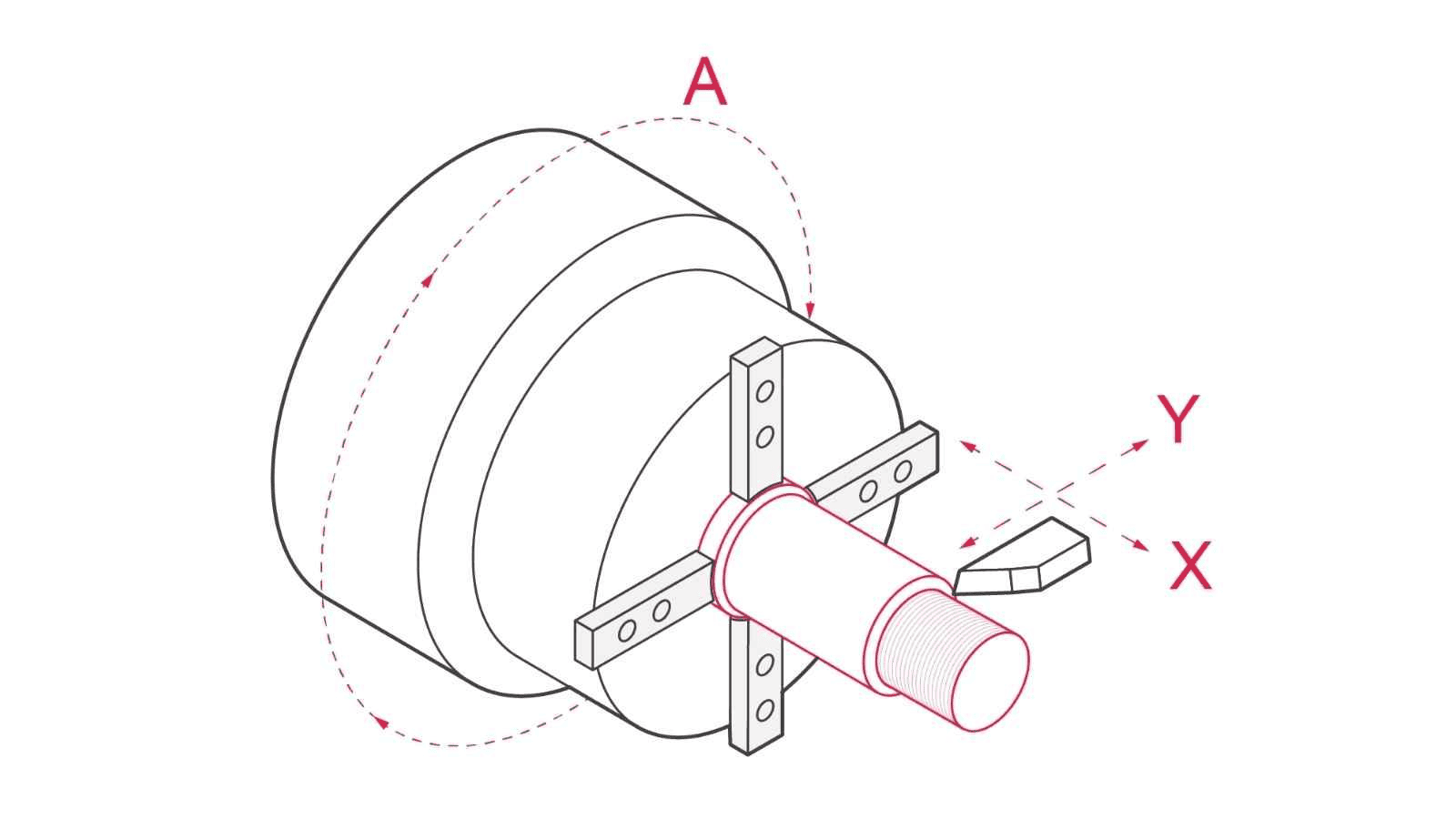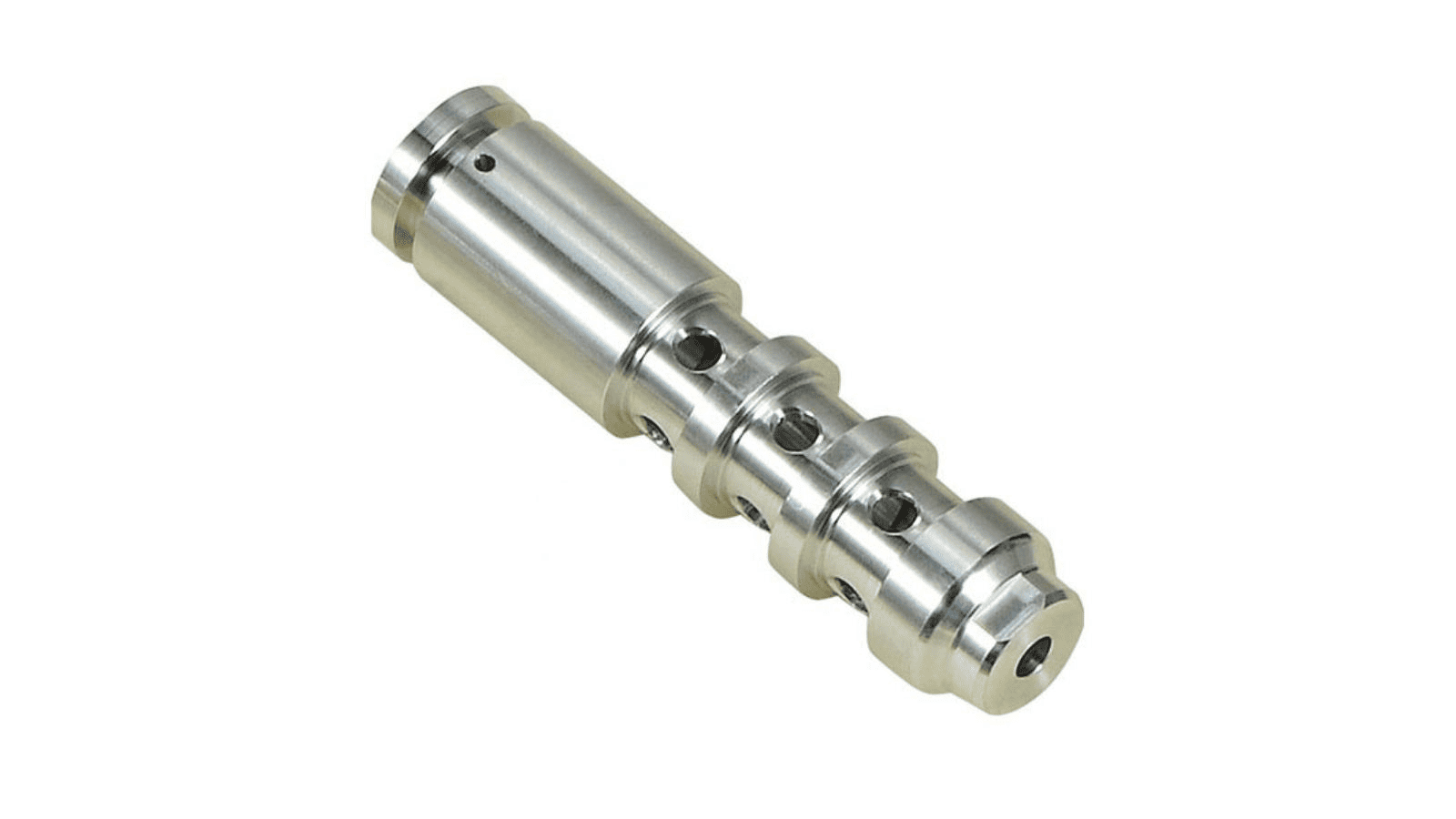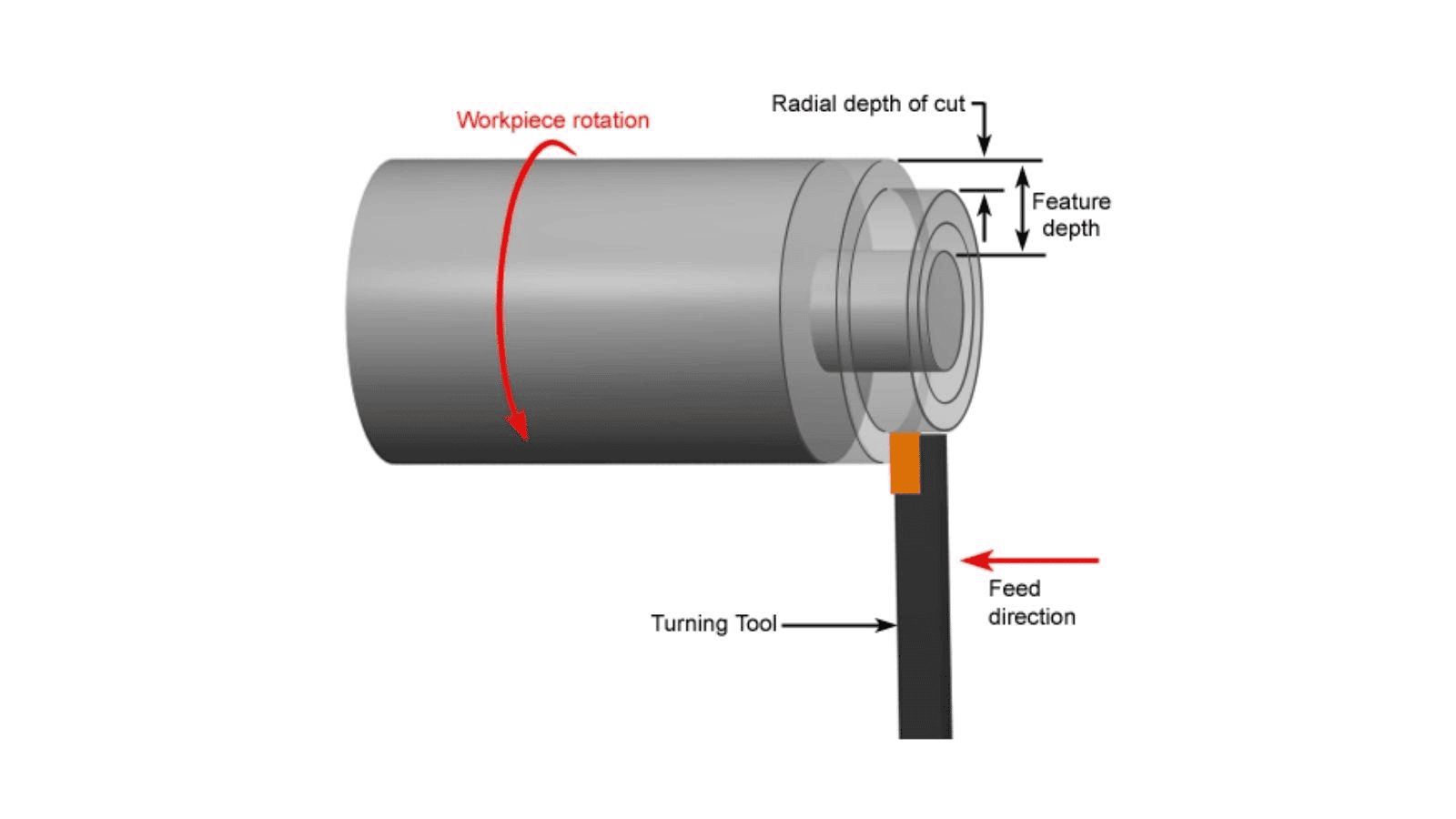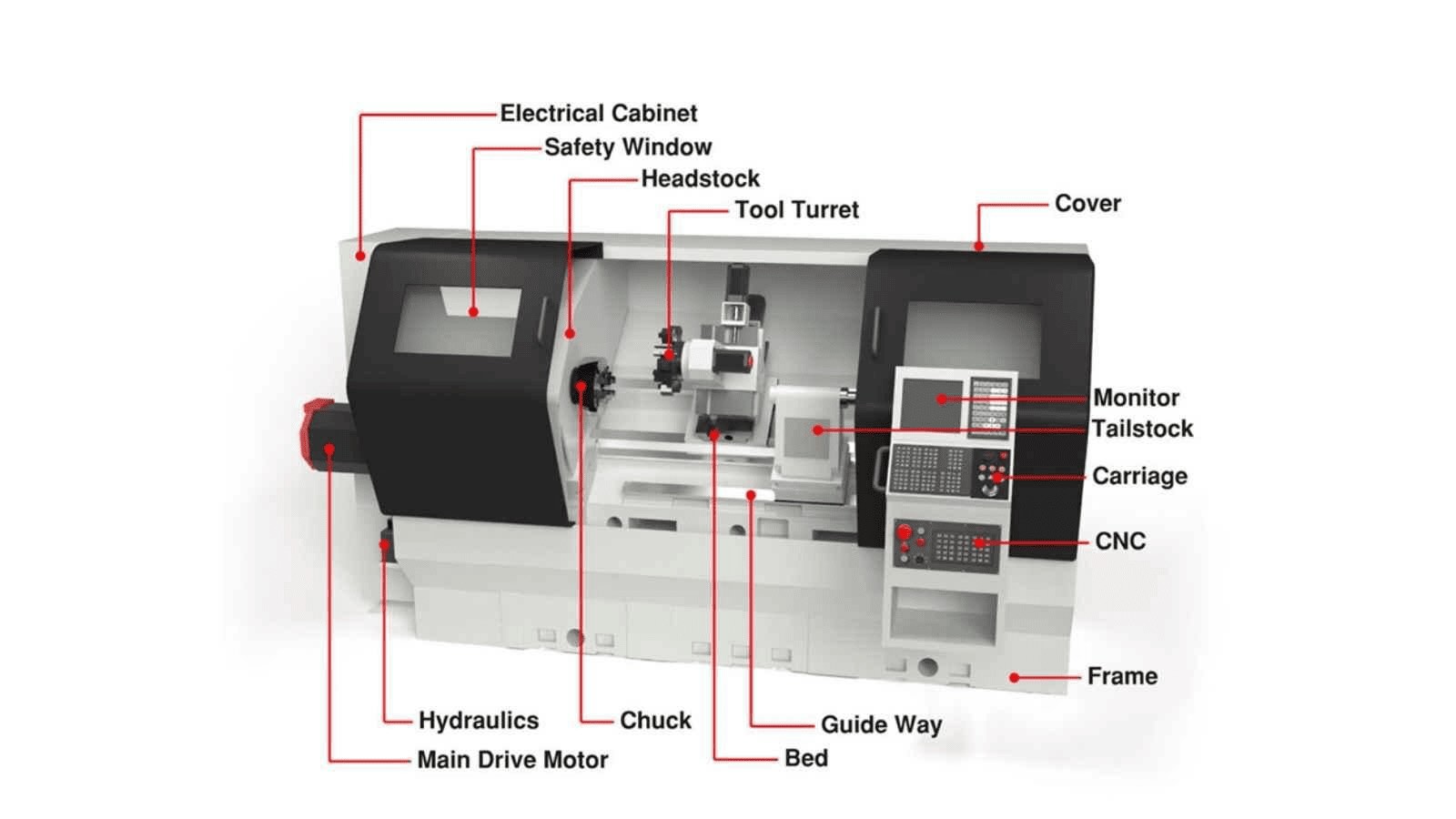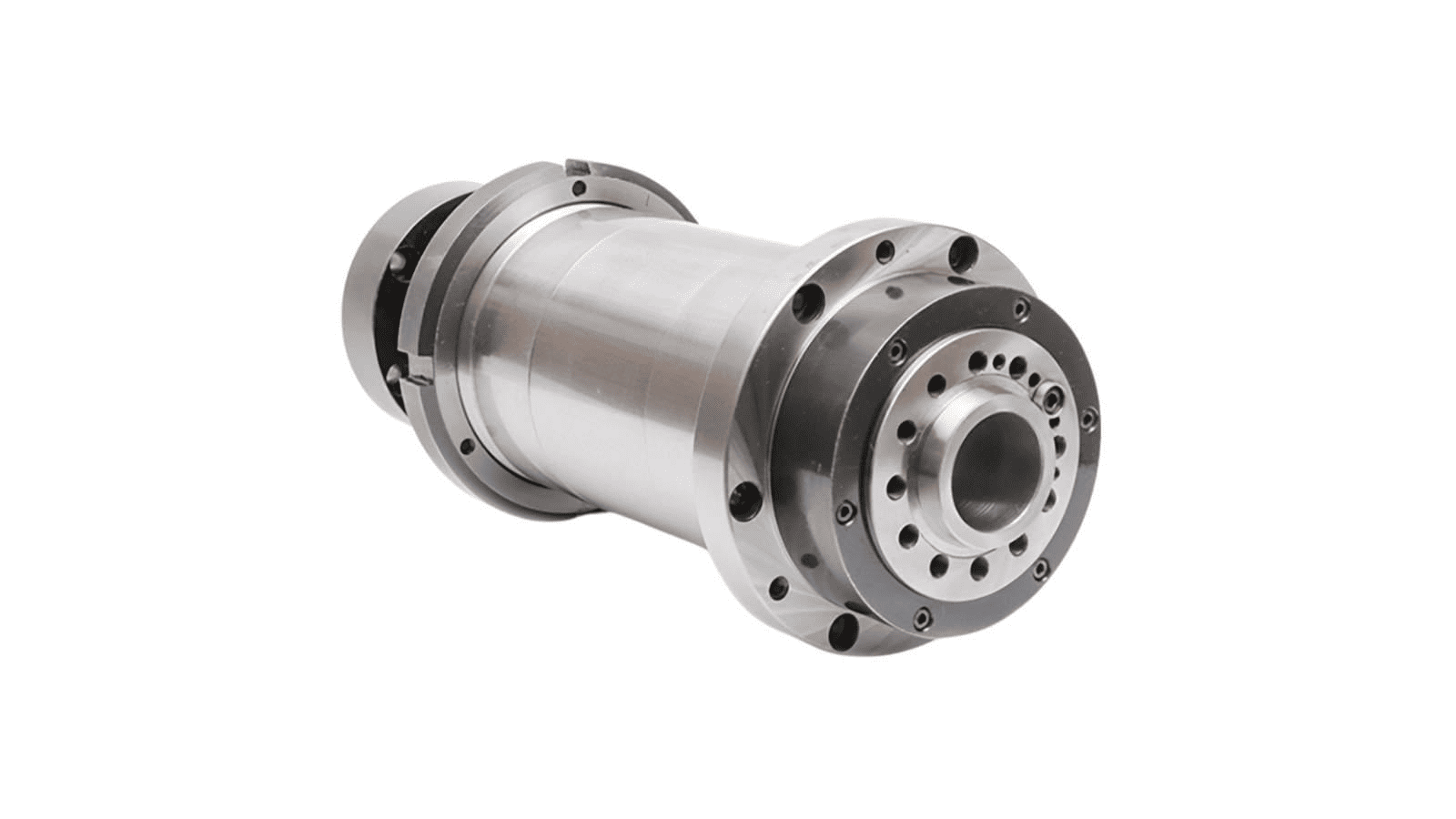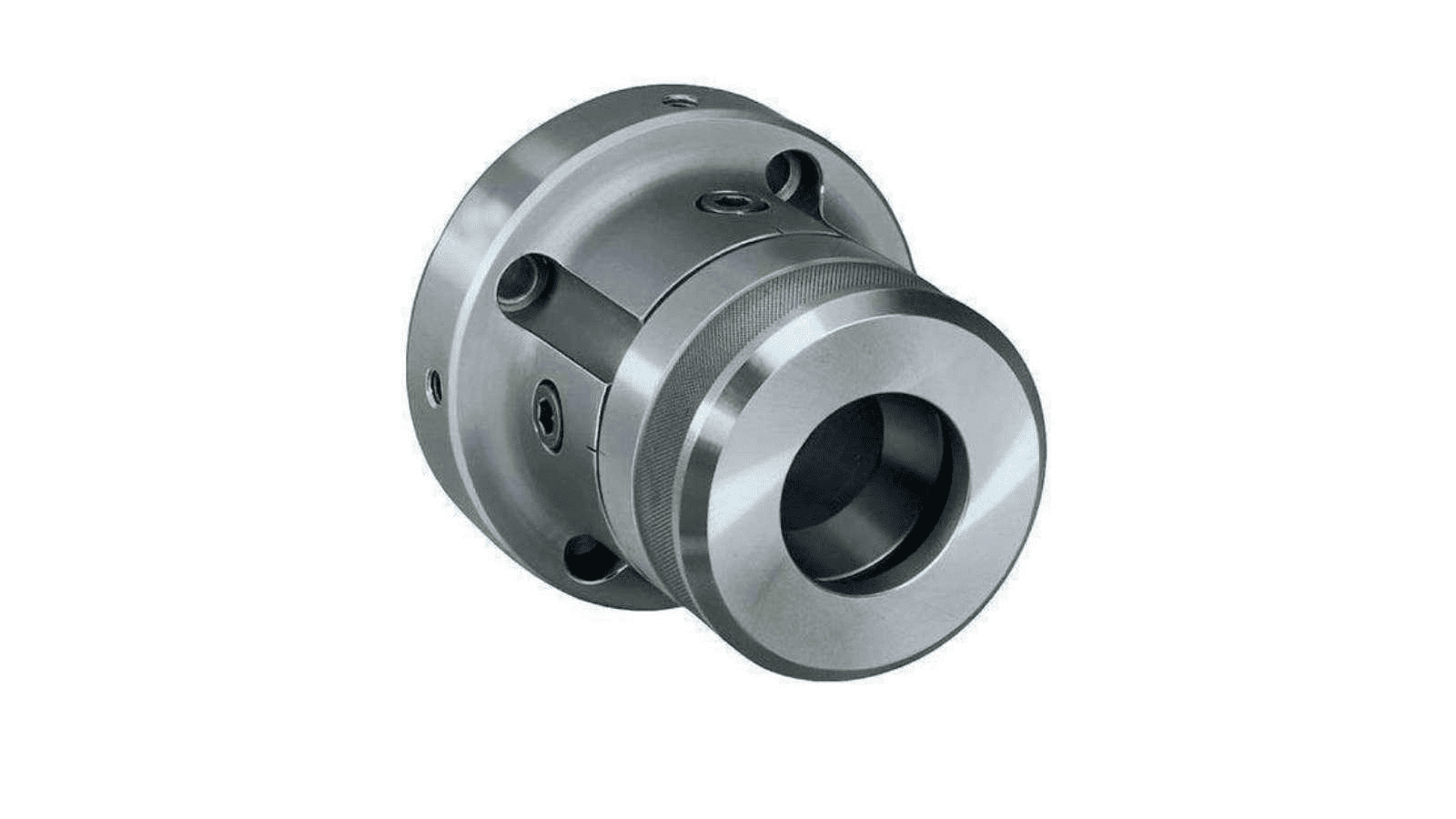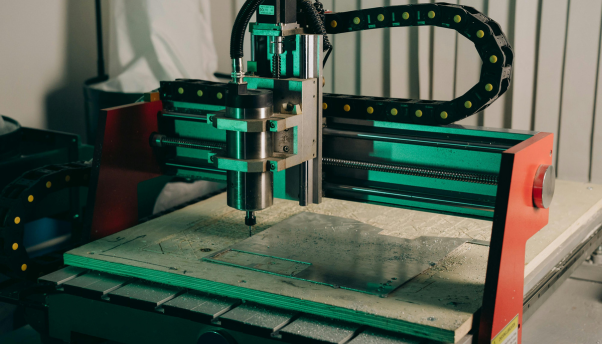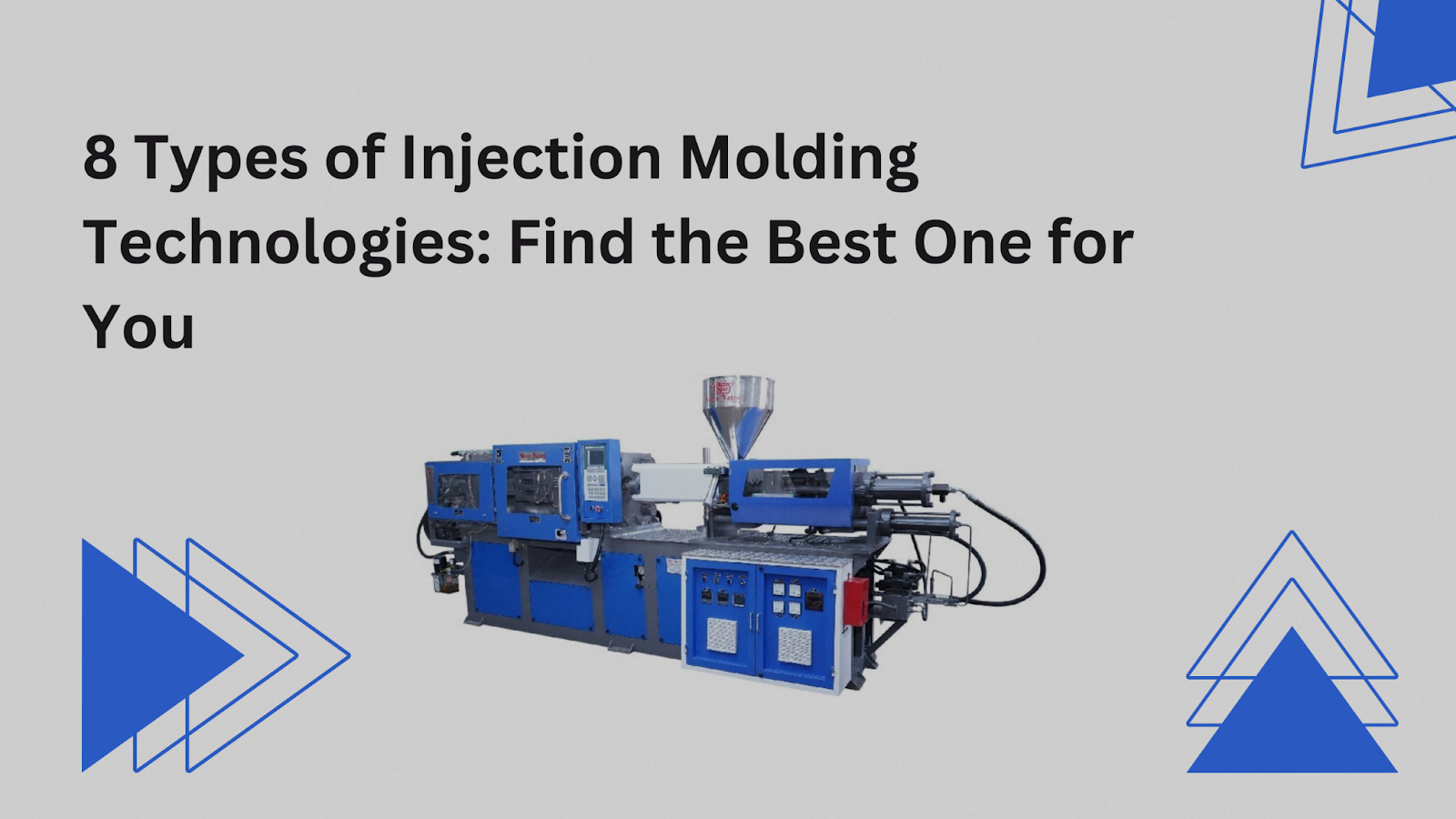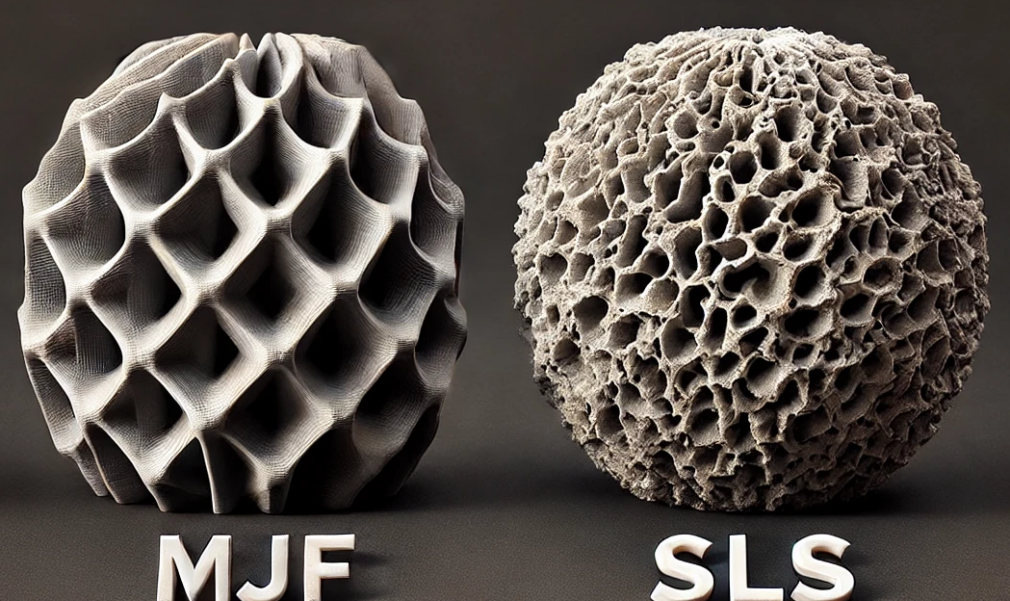In this guide, we will walk you through how CNC Turning works and its pros and cons and uses. Besides, You’ll also discover how to determine if CNC turning is the right choice for your product.
What Is CNC Turning?
Precision CNC turning is a widely adopted technique in the metal and plastic machining industry. It slices away part of a rigid job material/workpiece. In operation, the cutting tool remains static while the workpiece spins on its axis.
The spindle positions the workpiece and rotates it at a preset speed. While the tool works on predefined trajectories. Turning is optimal for tapered and cylindrical feature parts. It helps achieve tight or near-close tolerances, smooth finishes, and repeatability, which these components often demand.
The advanced CNC Lathe Machining controls the spindle, tool feed, and its movement on the Y-axis and is designed to do so with maximum efficiency. Multi-axis machines increase such capabilities by allowing contouring, drilling, and roughing of the internal bore in the same position. The right tool choice, cnc cutting speed, and cooling method allow the precision to be met. Moreover, it minimizes tool wear and material wastage.
Generally, aerospace, automotive, and medical manufacturers often need high-quality parts and utilize these for shafts, pins, bushings, implants, and custom fasteners. These, together with most metals, plastics, and composites, make CNC turning suitable for prototyping and mass production runs.
Get To Know More About Modern CNC Lathe Turning Machining, Here!
CNC Turning Processes
Let’s break down the process of cnc turning machine into a few chunks:
Step 1. Preparing the Workpiece
In general, a plastic or metal bar is selected depending on the actual part design and features needed. The selected raw material is then trimmed to the appropriate size and clamped into the lathe’s chuck or collet to keep it still during machining.
Step 2. Configure the CNC Machine
A CNC footprint of a part is created. It refers to the complete machining plan, including tool path, spindle speed, feed rate, depth of cut, etc. The program is uploaded into the CNC controller. Afterward, it takes care of the machining processes with great accuracy.
Step 3. Workpiece Positioning and Spindle Speed
After an alignment check, the workpiece is attached, and the spindle moves it at a pre-determined cutting speed. This alignment check is done to make sure there is not too much runout, which would spoil the end product.
Step 4. Removal of Material
The programmed cutter is fixed in place and moves across several dimensions to gradually refine the rotating workpiece. The tool casts aside the unnecessary parts of the workpiece in several passes, which are meticulously controlled to assure the accuracy and surface finish of the part.
Step 5. Post Machining Operations
These operations include, but are not limited to, drilling, knurling, fixing threads, and grooving. Multi-axis cnc lathe machining with live tooling can perform complex shapes without turning the part around.
Step 6. Inspection & Quality Control
Calipers, micrometers, and coordinate measuring machines (CMM) are used to check the dimensions of the machined part. This procedure is performed to confirm that the product is within its tolerances and fulfills the requirements.
Step 7. Finishing & Cleaning
At Future Parts, we apply coatings, anodizing treatment, polishing, and deburring necessary for surface quality, and it typically depends upon customer requirements. The part is then cleaned in preparation for shipment and final assembly.
CNC Turning Working Principle
In CNC turning, a workpiece is rotated while a cutting tool remains in place. Everything is managed by the CNC system, which thoughtfully controls the feed rate and the spindle speed along with its movement to achieve perfect accuracy every time. For greater machining complexity, multi-axis lathes allow the tool to move in multiple degrees of freedom.
Get in-depth insights about the Optimization of Machining Parameters in the CNC Turning of Stainless Steel here!
CNC Turning Important Parts
Here are the key CNC Turning Machine Parts
Spindle
The CNC lathe machine features a Spindle as its core rotating part to keep and spin workpieces at preset speeds. Changes in its rotation directly impact machining accuracy and the quality of surface finishing, as well as cutting efficiency. The spindle functions as the main controller of the machine’s rotation speed.
Chuck/Collet
The workpiece stays in position during machining through a Chuck or Collet. It avoids any movement and dislocation. Single parts require the use of collets instead of chucks. Small diameter workpieces are processed better with collets than with chucks. A chuck works most effectively for operating on larger workpiece dimensions.
Cutting Tool
Material extraction from workpieces takes place through the Cutting Tool in CNC-designed paths. The operator can generate both shapes and meet tolerances on the worked piece through its capability. The cutting tool comes in various materials, including tungsten carbide, high-speed steel, and ceramic.
Tool Turret
A tool turret accepts multiple cutting tools. It uses either manual or automatic tool selection, matching operational specifications. A single setup with the operator’s control reduction allows efficient multi-step machining, which produces better outcomes while requiring less processing time.
CNC Controller
Positioning the G-code commands into the CNC controller allows operations like spindle rotation with tool change, feed adjustment, and directional control of the machine. The machine operates through a controller unit, which requires monitoring and control functions to execute all necessary operations correctly and repeatedly.
Slides and Guideways
The slides, integrated with the guideways, allow the cutting tool to travel precisely in X, Y, and Z directions while achieving smooth motions. High-precision guideways control vibration and deflection. These could affect the accuracy of fine-tolerance parts during their motion.
Coolant
Coolant systems are effective because they deal with accumulated heat and minimize machining friction. As a result, the tool life duration and surface finish quality improve. The coolant system serves two functions: first, removing chips, and then maintaining a clean cutting surface, which allows continuous operation.
What is the Difference Between CNC Turning and CNC Lathe?
When it comes to CNC Turning, the process involves changing the shape of a material using cutting tools. In comparison, a CNC lathe is the machine/tool used to accomplish turning operations and material carving. Unlike a CNC lathe with parts that barely move at all, CNC turning is quite the opposite – a tool is put in place to cut into a workpiece that is constantly spinning. However, a CNC lathe is still able to provide features like rotational spindles and motion from tools with control automation.
Differentiating CNC Turning and CNC Lathe
| Factor | CNC Turning (Process) | CNC Lathe (Machine) |
| Definition | A machining process that removes material from a rotating workpiece. | A machine tool that performs CNC turning operations. |
| Operation/Function | Shape cylindrical parts using a cutting tool. | Provides spindle rotation, tool movement, and automation. |
| Role | A specific manufacturing operation. | The equipment used to execute turning processes. |
| Components | Cutting tool, tool path, feed rate, and spindle speed. | Spindle, chuck, tool turret, CNC controller, and slides. |
| Types | Includes operations like facing, threading, and boring. | Comes in types such as 2-axis lathes, multi-axis lathes, and Swiss lathes. |
| Automation Level | It is defined by CNC programming. These controls cutting movements. | Offers varying levels of automation based on machine type. |
| Application | Used to manufacture shafts, pins, and cylindrical components. | Used in industries like aerospace, automotive, and medical manufacturing. |
Advantages and Disadvantages of CNC Turning
Advantages:
CNC Turning technology provides exact dimensional precision. It can reach ±0.005 mm.
The machine setup allows operators to maintain a uniform surface speed control (CSS). So, it delivers a uniform finish on parts with varying dimensions.
Turning supports multiple tool turrets in addition to live tooling functions. Therefore, it minimizes the need for subsequent processing stages.
Also, the system incorporates mechanical rigidity and vibration-attenuating design features. So, it helps achieve optimal cutting dimensions in millimeters and microns.
The system makes automatic speed rate changes that lead to better machining performance.
Complex part programming and simulations become possible through the software integration between CAD/CAM systems.
Disadvantages:
The machine needs strong spindle power capabilities to cut through hard materials, including titanium and Inconel.
The high cutting speed operation produces excessive heat that requires sophisticated coolant systems.
Somehow, lathes cannot execute complex non-rotational forms. So, it may lead to supplementary milling operations for completion.
Tool holders, along with inserts, require regular calibration procedures as part of periodic maintenance.
The process of high-speed turning produces chip entanglement. This causes tool life and degrades surface quality.
Specialized parts demand additional time to install custom fixtures and work holding devices. As a result, it extends the total production duration.
Application Areas of CNC Turning
CNC turning plays an indispensable role in several industries that require high-precision cylindrical and symmetrical components. It enables tight tolerances, efficient mass production, and complex part geometries while maintaining cost-effectiveness.
Common Products by Industry
| Industry | Common CNC-Turned Products |
| Aerospace | Jet engine spools, actuator pistons, satellite connectors |
| Automotive | Turbocharger shafts, fuel injector nozzles, gearbox hubs |
| Medical | Titanium bone screws, endoscopic instrument handles, surgical drill bits |
Is CNC Turning Right for Your Product?
The complexity of Product Design
CNC turning is highly accurate and is perfect for symmetrical and cylindrical parts. In the case that your design has tapered surfaces, threads, or grooves, turning can accomplish those features. With more advanced lathes containing live tooling, secondary machining can be reduced to assist with additional details such as holes and flats.
On the other hand, if your design has deep cavities, undercuts, and irregular shapes, it may require some multi-axis machining alongside CNC milling. Knowing the geometry of your design will help in evaluating the effectiveness of using turning as an option.
Material Considerations and Precision
When it comes to precision, materials are the final frontier. Stainless steel, aluminum, titanium, and engineering plastics are just some of the varied materials that CNC turning can work with. As for the precision, turning is capable of getting the accuracy within microns.
Maintaining tool wear and surface finish can be greatly impacted by the chosen material. For products that require narrow tolerances and consistently good quality, precision CNC turning will ideally help achieve these results.
Production Volume
CNC turning can work for both small and large production runs, depending on the equipment in place. The setup and programming costs can be significant for low-volume units, making each unit more expensive. However, automation and consistent repeatability in high-volume production result in lower costs per unit.
Advanced CNC lathes equipped with bar feeders can operate non-stop. This greatly improves efficiency for large orders. If you want flexible, scalable manufacturing, CNC turning can be the go-to choice.
Cost and Waste Considerations
CNC turning is economical due to reduced material waste from unused cutting paths. However, with any setup, low-volume runs suffer due to expenses from automation setup time, tooling costs, and machine wear. While high-speed turning increases efficiency, it also improves the rate of tool wear and replacement needed.
Some materials, like titanium, produce stringy chips, which can lead to defects if not handled properly. When planned properly, CNC turning can be a great option for cost-effective production with little waste.
Get Premium Quality CNC Turned Parts From Us
Choosing the right CNC turning supplier is paramount for guaranteeing accuracy, effectiveness, and reliability over time. Your partner must be equipped with sophisticated machining capabilities. They provide effective quality control and decades of experience with various materials. Moreover, they should be able to address your requirements by offering custom, rapid, and affordable solutions.
Future Parts is dedicated to offering high-quality CNC turning services. Our facility uses the latest machinery and qualified personnel. We carry out stringent quality control to guarantee consistency while also enabling accurate lead time reductions. We provide flawless prototypes and large quantities at competitive prices.
Get in touch with Future Parts and get precision CNC turned parts now.
Summary
CNC turning is a high-precision machining procedure where material is removed from a rotating workpiece to form cylindrical and symmetrical parts. This process is common in aerospace, automotive, medical, and industrial manufacturing due to the tight tolerances, high efficiency, and smooth surface finishes offered. Moreover, it supports a variety of materials, including metals and engineering plastics, and is optimal for low-volume prototyping as well as large-scale production. However, selecting the right supplier guarantees quality, consistency, and cost-efficient pricing.
FAQs
Q1: Mention the materials that CNC turning can process.
CNC turning can process metals like aluminum, stainless steel, titanium, and brass, as well as plastics such as PEEK, Delrin, and ABS, depending on application needs.
Q2: What are the typical tolerances in CNC turning?
Most precision CNC turning achieves tolerances of ±0.005 mm. But high-precision setups can go even tighter, depending on machine capability and material features.
Q3: How does CNC turning compare to CNC milling?
CNC turning is ideal for cylindrical parts created by rotating the workpiece. On the other side, CNC milling removes material from stationary parts using rotating tools to produce complex shapes.
Q4: Can CNC turning produce complex geometries?
Yes, advanced multi-axis CNC lathes with live tooling allow for drilling, slotting, and contouring. Besides, these reduce the need for secondary machining.
Q5: What factors affect CNC turning costs?
Usually, costs depend on material type, part complexity, production volume, surface finish requirements, and tool wear, with higher precision and tighter tolerances increasing costs.
Q6: How do I choose the right CNC turning supplier?
Look for a supplier with modern equipment, skilled machinists, strict quality control, and a proven track record in precision machining, like Future Parts.

